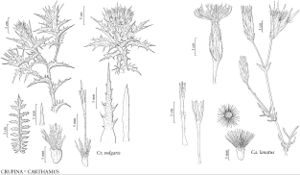Crupina
Ann. Mus. Natl. Hist. Nat. 16: 157. 1810.
| Taxon | Illustrator ⠉ | |
|---|---|---|
 | Crupina vulgaris Carthamus lanatus | John Myers John Myers |
Annuals, 20–100 cm, not spiny. Stems erect, openly branched distally. Leaves basal and cauline (distally reduced to bracts); sessile (basal) or petiolate (cauline); blade margins entire or toothed to pinnately divided (basal) or 1–2-pinnately divided (cauline). Heads radiant, borne singly or clustered at branch tips. Involucres cylindric to ovoid. Phyllaries overlapping in 4–6 series, unequal, oblong-lanceolate, acute, unappendaged. Receptacles flat, epaleate, bearing subulate scales. Florets 3–15, outer 2–14 neuter, inner 1–2 fertile; corollas purple, ± bilateral, tubes slender, gradually expanded into narrowly funnelform throats, lobes linear; anther bases short-tailed, apical appendages narrowly triangular; style-branches: fused portions with minutely puberulent nodes, distinct portions very short, triangular. Cypselae cylindric [or ± compressed], bases puberulent, faces smooth, not ribbed, distally softly pubescent, attachment scars basal [or lateral]; pappi persistent, present only on fertile florets, outer 1–2 series of numerous stiff, minutely barbed bristles, inner of 5–10 short lacerate-dentate scales. x = 28, 30.
Distribution
Introduced; Europe, Asia, n Africa
Discussion
Species 3–4 (1 in the flora).
Crupina is a member of subtribe Centaureinae. Molecular phylogenetic studies (A. Susanna et al. 1995; N. Garcia-Jacas et al. 2001) place Crupina in a basal grade of genera related to Centaurea. Crupina differs from Centaurea by having scaly (rather than bristly) receptacles, and in its cypselar structure (J. Briquet 1930), trichome types (J. Briquet 1930b), unique pollen morphology (G. Wagenitz 1955), and high chromosome base number.
Selected References
Lower Taxa
"fine" is not a number.